St. Alban Lodge No. 529
Three Handled Loving Cup
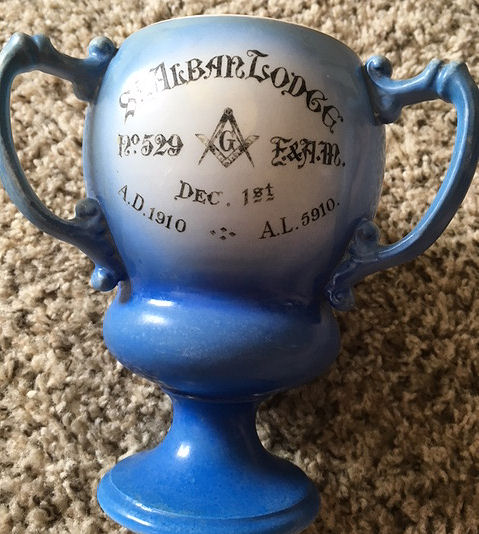
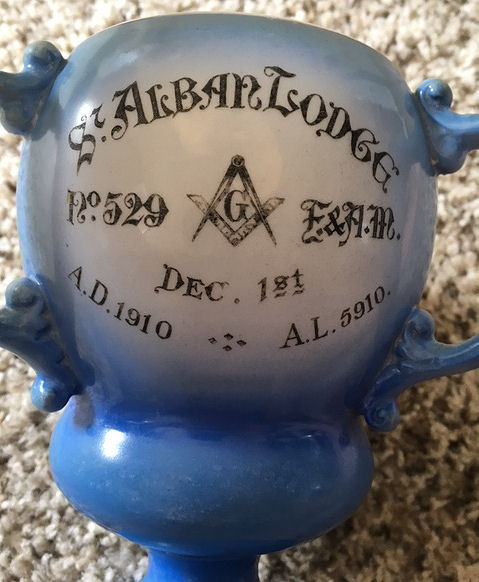
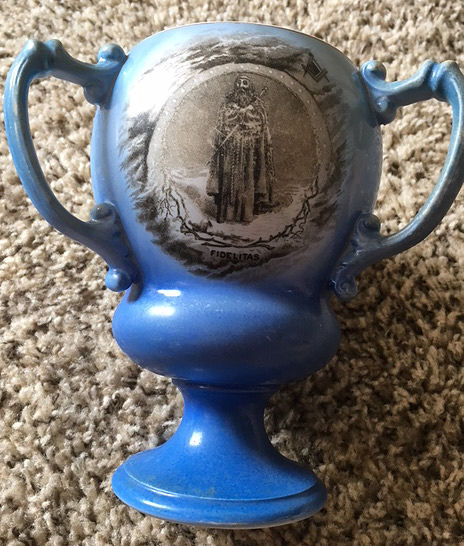
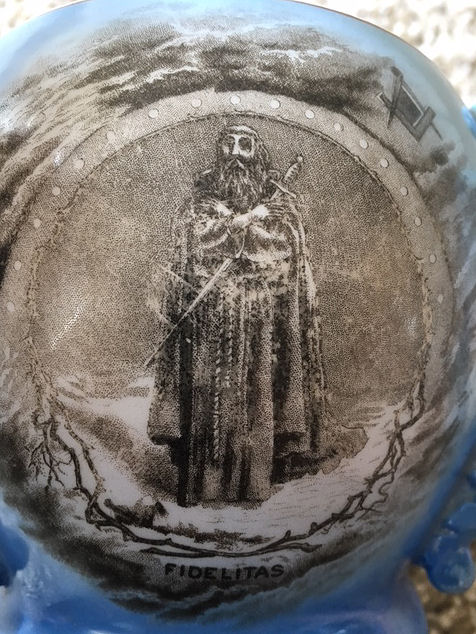
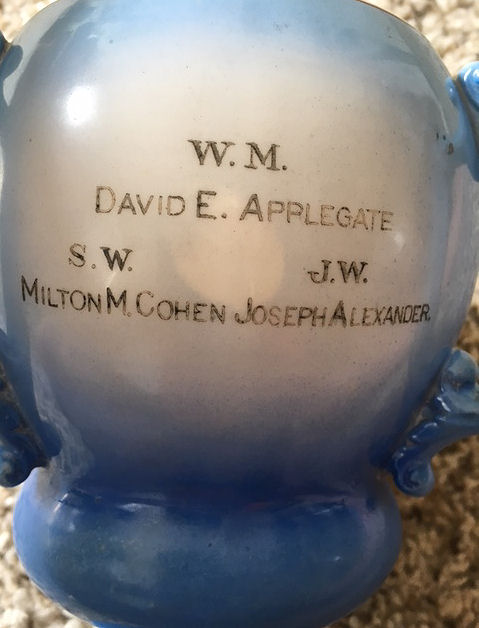

This cobalt blue Three Handled Loving Cup was made for
St. Albans Lodge No. 529 F.&A.M. and is dated December 1st, 1910. It pictures
Fidelias on one of its three panels and names the three principle officers of
the Lodge on another panel. It was made by Thomas Maddox Sons, Co., of Trenton,
New Jersey and stands 7 1/4 inches tall.
History of St. Alban
Saint Alban (;
Latin: Albanus) is
venerated as the first-recorded British Christian martyr,
and he is considered to be the British protomartyr. Along with
fellow Saints Julius and Aaron, Alban is one of three named martyrs recorded at
an early date from Roman Britain ("Amphibalus" was the name given much later to
the priest he was said to have been protected). He is traditionally believed to
have been beheaded in the Roman city of Verulamium (modern St Albans) sometime
during the 3rd or 4th century, and his cult has been celebrated there since
ancient times.
According to the most
elaborate version of the tale found in Bede's Ecclesiastical History of the
English People, Alban lived in Verulamium, sometime during the 3rd or 4th
century (see dating controversy below), but some authors, on the basis that
Gildas says he crosses the Thames before his martyrdom, place his residence
and martyrdom in London.
He lived in Roman Britain, but little is known about his religious
affiliations, socioeconomic status or citizenship. Sometime in the 3rd or 4th
century, Christians began to suffer "cruel persecution."
Alban met a Christian priest fleeing from "persecutors" and
sheltered him in his house for a number of days. The priest (who later came to
be called Amphibalus, meaning "cloak" in Latin) prayed and "kept watch"
day and night, and Alban was so impressed with the priest's faith and piety
that he found himself emulating the priest and soon converted to Christianity.
Eventually it came to the ears of an unnamed "impious prince" that Alban was
sheltering the priest. The prince gave orders for Roman soldiers to make a
strict search of Alban's house. As they came to seize the priest, Alban put on
the priest's cloak and clothing and presented himself to the soldiers in place
of his guest.
Alban was brought before the
judge, who just then happened to be standing at the altar, offering sacrifices
to "devils" (Bede's reference to pagan gods). When the judge heard that
Alban had offered himself up in place of the priest, he became enraged that
Alban would shelter a person who "despised and blasphemed the gods, "and as
Alban had given himself up in the Christian's place, Alban was sentenced to
endure all the punishments that were to be inflicted upon the priest unless he
would comply with the pagan rites of their religion. Alban refused, and
declared, "I worship and adore the true and living God who created all things."
(The words are still used in prayer at St Alban's Abbey).
The enraged judge ordered
Alban scourged, thinking that a whipping would shake the constancy of his heart,
but Alban bore these torments patiently and joyfully. When the judge realized
that the tortures would not shake his faith, he ordered for Alban to be
beheaded.
Alban was led to execution,
and he presently came to a fast-flowing river that could not be crossed
(believed to be the River Ver). There was a bridge, but a mob of curious
townspeople who wished to watch the execution had so clogged the bridge that the
execution party could not cross. Filled with an ardent desire to arrive quickly
at martyrdom, Alban raised his eyes to heaven, and the river dried up, allowing
Alban and his captors to cross over on dry land. The astonished executioner cast
down his sword and fell at Alban's feet, moved by divine inspiration and praying
that he might either suffer with Alban be executed for him.
The other executioners
hesitated to pick up his sword, and meanwhile, Alban and they went about 500
paces to a gently sloping hill, completely covered with all kinds of wild
flowers, and overlooking a beautiful plain (Bede observes that it was a
fittingly beautiful place to be enriched and sanctified by a martyr's blood).
When Alban reached the
summit of the hill, he began to thirst and prayed God would give him water. A
spring immediately sprang up at his feet. It was at there that his head was
struck off, as well as that of the first Roman soldier who was miraculously
converted and refused to execute him. However, immediately after delivering the
fatal stroke, the eyes of the second executioner popped out of his head and
dropped to the ground along with Alban's head so that this second executioner
could not rejoice over Alban's death.
In later legends, Alban's
head rolled downhill after his execution, and a well sprang up where it stopped.
Upon hearing of the miracles, the astonished judge ordered further persecutions
to cease, and he began to honour the saint's death.
St Albans Cathedral now stands near the
believed site of his execution, and a well is at the bottom of the hill,
Holywell Hill.
Above description is from
Wikipedia
The Ceremony
of the Loving Cup
An Ancient Masonic Ceremony of Sharing
Author
Unknown
This is an old tradition in Wellington Lodge No. 1385 usually performed at the
conclusion of a banquet. It is a very old custom which seems to have almost died
out, at least in Craft Masonry. Wellington tries to maintain this tradition and
is famous for it.
Actually the Loving Cup should be passed after the Entered Apprentice song has
been sung. This is a ceremony handed down through the ages and need not be
limited to initiations, which Wellington does not do.
The procedure was for three Brethren to stand, two would unsheath their swords
and the third (middle) to hold up the cup by the two handles and to drink whilst
the two others defended him, one facing him and the other with his back to the
drinker’s back. Having taking his draught, the drinker then wipes the cup with a
napkin. The two brethren with thier backs together then turn to face each other
and the cup is handed over. The next brother in the line now stands to protect
the back of the drinker, and so on.
A later variation of the Loving Cup for toasting is the large two handled
wassail bowl or cup, usually pewter or silver and sometimes bearing the Lodge
badge or crest. At the festive Board it is passed round from Brother to Brother
around the table. The word “wassail” comes from the old English “Waes Hail”,
meaning “Be thou whole and of good health”. The custom of protection of the
drinker’s back is said to date back to Saxon times, when a man might be
treacherously stabbed whilst drinking - hence a friend or two defend him with
drawn swords. This may be borne out by the murder, in A.D. 979 of King Edward
(later known as Edward the Martyr), when he was so stabbed on the orders of his
stepmother, Elfrida, so that her own son, Ethelred could become King instead. He
was stabbed at the feast while drinking mead from a two handled loving cup by a
paid assassin.
There are many forms of the ceremony but the process of sharing, coupled with
mutual protection is the same — it reinforces the ancient Masonic bond we have
with each other.
A Special "Thank
You" to Wor. Bro. Fred Lowstetter for sharing his photos of this beautiful
Loving Cup!

